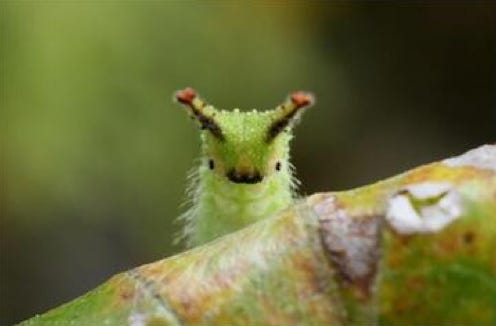In the first essay of Artist’s Corner on the topic of caterpillars, I wrote that
I see caterpillars representing the start of change, the start of something new.
Caterpillars eventually go through metamorphosis to become a moth or a butterfly. In this mini-essay, we’ll be talking about the butterfly. To me, a butterfly represents a symbol for rebirth, new attempts, and trying new things. Butterfly symbolism, while similar to a caterpillar, is different due to symbolically representing advancement to say a new level, whether it be new knowledge, growth, exploring different paths, etc.
<^>^<^>^<^>^<^>^<^>^<^>^<^>^<^>^<^>^<^>^<^>^<^>^<^>^<>
The Butterfly
While looking into the butterfly from a cultural perspective, various sites that I saw also depicted the butterfly as a representation of change-sometimes good and sometimes bad, depending on one’s interpretation. A few websites suggested that they are the climate change canary-that is currently, as the planet becomes warmer, butterflies are migrating to colder climates that they normally would not inhabit. Butterflies have even been depicted in art as symbolic opposites of cultural beliefs, especially depending on what colors the artist may be using to depict the form of this smol, beautiful, and magnificent insect.
The butterfly represents different perspectives in various cultures. The butterfly symbolizes renewal, transformation, the soul and immortality, love and joy, transience and impermanence, resurrection and rebirth, dreams and inspiration. Since this is not one of my regular musing essays and I’m trying to keep this short-ish, here are two links to a blog and an article about the representation of the butterfly in culture.
<^>^<^>^<^>^<^>^<^>^<^>^<^>^<^>^<^>^<^>^<^>^<^>^<^>^<>
Japanese Emperor Butterfly
The Japanese Emperor Butterfly is the national butterfly of Japan, but it is also native to China, the Korean Peninsula, and the northern parts of Taiwan and Vietnam. The males have five colors and a slightly smaller wingspan than the females who are two-colored and slightly larger. They tend to stay high up in the trees and only fly down to the ground to feed.
The Japanese Emperor Butterfly’s scientific name is sasakia choranda. It’s local name is oh-murasaki which translates to “great purple emperor”. If you’re interested in learning more about the colors of the Emperor…
…If you’re interested in learning more about the colors of the Emperor Butterfly and don’t mind a bit of sciency reading, I recommend reading the link to this study-I only skimmed it, and it’s about 10 pages long, but it goes into detail about the coloration and structure of this specific butterfly, and you don’t even need to be affiliated with a university to read it. Huzzah to True Open Access!
In Japanese culture, the butterfly represents the cycle of life and death, and also represents the soul of the deceased. This representation is similar to the ancient Greek representation of the soul and the goddess Psyche, goddess of the soul, whose symbol was also the butterfly. This is also slightly different than the Christian representation, which sees the butterfly as a symbol of resurrection.
When I was working on the painting that is shown in the next section and even in the present when I look at this work, I think of a friend from Japan. I met him when he was interning at a museum I use to work at before moving. We got along and became friends pretty quickly. By the time I had made this print, though, he was back in Japan and we have since lost touch. We’ve only messaged once on Facebook, and he said that he couldn’t remember much English. I tried to use Google Translate to strike up a conversation, but he never responded back. But every so often, we write Happy Birthday on the others wall, so I’m glad to say that whatever translation I put in Messenger didn’t scare him away!
I didn’t know at first, when I first saw the image of the butterfly, that it was native to Japan. I just thought it was pretty and my inner-artist wanted to bring that beautiful image to life via a watercolor mono-print. It was shortly after I had completed the work did I go back and look up a bit about the butterfly.
This was also suppose to be my first post for Artist’s Corner, until I started researching the caterpillar and *cough* allowed *cough* myself to be distracted and go in that direction.
<^>^<^>^<^>^<^>^<^>^<^>^<^>^<^>^<^>^<^>^<^>^<^>^<^>^<>
Medium-Type and Print Process
My second semester of taking art, I took Drawing II, a class that I would take repeatedly-with a brief intermission of Printmaking I-until December 2020, one month before moving to the city where I’m currently going to school. My then-instructor, who has a Masters in Printmaking and still teaches me something about art whenever I just randomly pop into his class to say hi, taught us a few other things besides drawing that first semester of Drawing II, such as the image below. The image below is a mono-print (for the uninitiated-meaning only one print). The medium used was watercolor.
Also for the uninitiated, there are various ways to make a mono-type. My instructor had several different sizes of printing presses that students had access to-with the new students under being under supervision, of course, until they’d been there for at least one or two more semesters! The process is simple, but there are many steps too it that I won’t go into. Basically, I sanded my plexiglass, drew an outline on it, and added my colors the opposite way that they would look on the paper-so if I wanted blue on the right side, I’d put blue paint on the left side of the plexiglass, and so on/so forth. I then wet some paper, let it get damp on a towel, put the plexiglass between four slim pieces of wood, put the paper on top of the plexiglass, cranked the materials through the press, thus transferring the image from the plexiglass to the paper. I also did a few ghost prints, as well.
This is not the only way to make prints, and you certainly don’t always need a press, or to draw an outline on plexiglass. YouTube also has some great videos if your curiosity has been piqued about the process.
The specific butterfly that this image is based off of is the continuously mentioned Japanese Emperor Butterfly. I attempted to make an exact imitation of the male butterfly colors and shape. At the time I was making this painting, I didn’t know that it was a male. Honestly didn’t know the difference until I researched this beautiful insect for this mini-essay-at least, ya know, mini for me! I mean, imitation is the best form of flattery, right? At least in art! Look in awe at the Emperor Butterfly, for they may be smol, but they be stunningly mighty!
Also, let us take a moment to fawn over the caterpillar form of this butterfly!
Gonna be honest here, y’all-watercolor is NOT my forte. I love watercolor paintings and prints, but I absolutely hate even attempting to make watercolor anythings. But I wanted to pass the class, and my teacher and I were not yet on that level of friends-student-mentor-friends yet, so I did what I do best in these scenarios and go along with what teacher said to do…to the best of my ability. I’m sure if you really look at the image, you’ll be able to see which parts he did and which parts I did. I’ll give you a humongous and quite obvious hint: the parts that look more like acrylic or too damn watery…are what I did. Happy hunting! :D
<^>^<^>^<^>^<^>^<^>^<^>^<^>^<^>^<^>^<^>^<^>^<^>^<^>^<>
Conclusion: Currently in a Cocoon, But Definitely Feeling the Change and Pain of Growth
As previously mentioned, to me a butterfly represents going from the start of change to actively making that change happen. While I still feel like I’m in the cocoon stage education and career-wise, I hope that when I emerge, I will still have that same sense of courage, curiosity, and wanderlust that started me on the journey that I’m currently on, but with more knowledge of how to do the things. Ya know?
To anyone else who comes across this mini-essay who still feels like they’re in their own cocoon, once you come out, may you feel as transformed and/or <insert any cultural reference from your culture>, may you remember that even though you may be “grown”, growth and learning does not have an age limit-and it certainly doesn’t discriminate based on where you come from!
I would also like to leave you with a question: What does the butterfly and caterpillar mean to you personally? Are they just insects that contribute to the circle of life? Or do they mean something more to you? I’d love to know your thoughts to these questions, dear Fellow Musers💜
Thank you for taking the time to read and/or listen to this. I hope you enjoyed this mini-essay!
Carpe Diem and Huzzah!
~Kimber~
Speaking of nature, here is a video of geese flying in perfect, organized formation to their more southern and warmer skies!









So wonderful and wise awesome one!x
I love how there is so much to dissect here, Kimber!! Such a beautifully written analysis that is very interesting but also very wise and something that I know I will come back to when I need more perspective on life and simple reminder that it's never too late to come out of that shell and become that beautiful butterfly in my life. Thank you so much for your beautiful words 💚